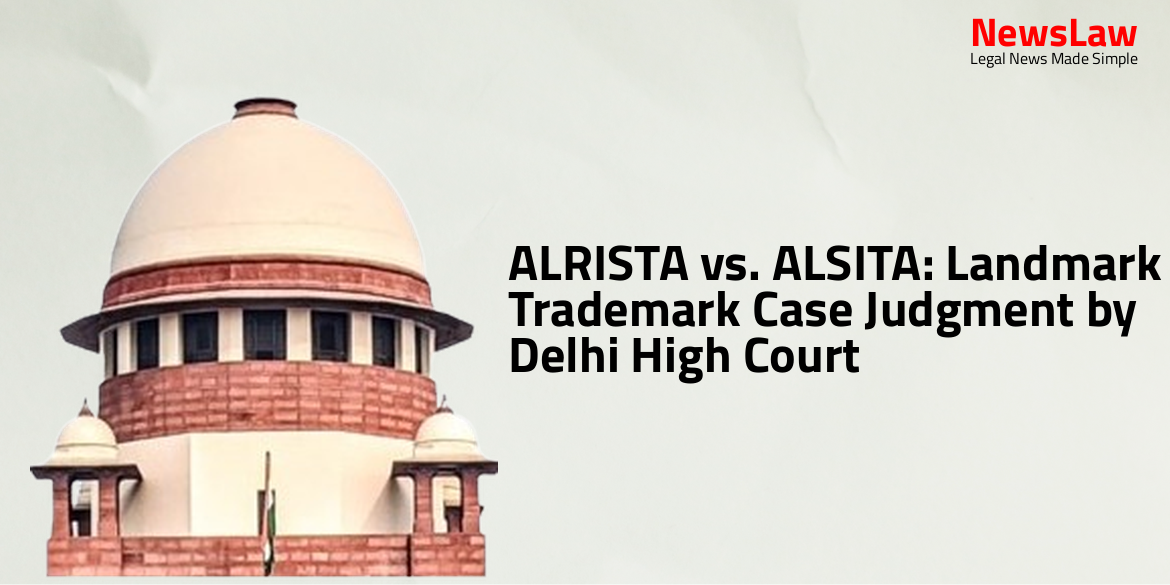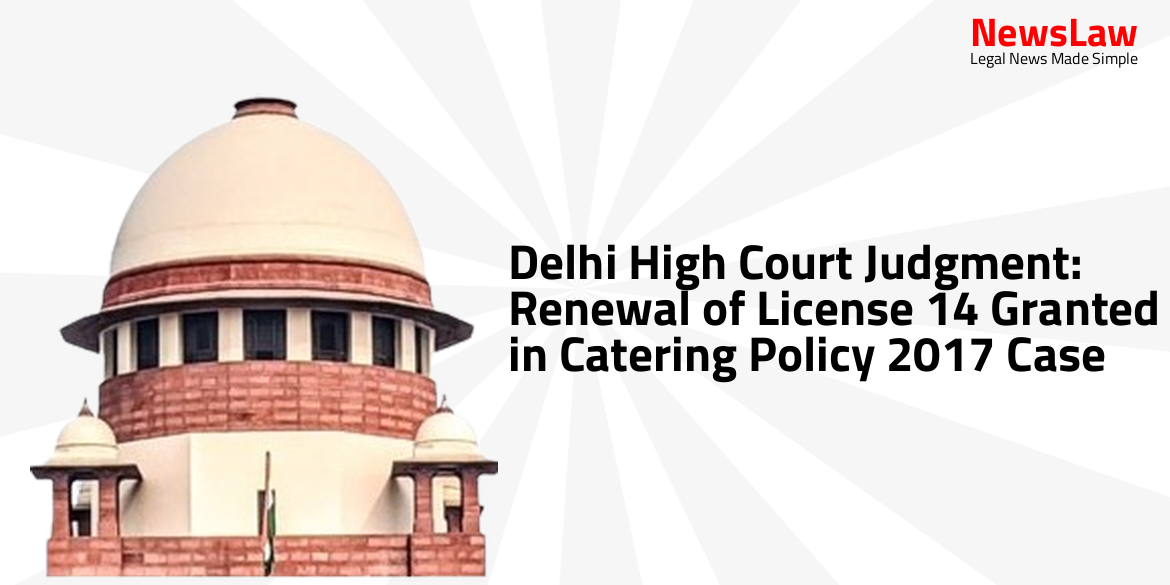In a pivotal decision by the Delhi High Court, the case of ALRISTA vs. ALSITA has set a precedent in the realm of trademark disputes, particularly within the pharmaceutical industry. The judgment sheds light on the complexities of brand confusion and patient safety, highlighting the critical need for distinctiveness in medicinal product labeling.
Arguments
- The defendant’s use of the impugned mark may result in tarnishment or blurring the distinctive link between the plaintiff and their products.
- The plaintiff claimed balance of convenience in their favor.
- Visual, structural, and phonetic similarities between the marks are to be assessed from the perspective of an average consumer with imperfect recollection.
- The plaintiff seeks a decree of permanent injunction to restrain the defendant from using the trademark ‘ALSITA’ or any similar mark to ‘ALRISTA.’
- Relief is sought under Sections 27 and 29 of the Trademarks Act, 1999.
- Plaintiff claims a right in their registration and an honest adoption of the mark ‘ALSITA’ based on their house name ‘ALKEM’ and the Active Pharmaceutical Ingredient ‘Sitagliptin Phosphate’.
- Plaintiff challenges the validity of the defendant’s trademark registration, stating it was granted in violation of Section 11 of the Act.
- Despite plaintiff’s mark not being registered, they assert a common law right in passing off as both parties sell through the same trade channels.
- Plaintiff alleges defendant’s adoption of the mark is dishonest and an attempt to benefit from plaintiff’s goodwill and reputation since 2007.
- Plaintiff mentions various other trademarks with the prefix ‘AL’ in Class 5 to show the common usage in the pharmaceutical industry.
- Plaintiff emphasizes that defendant’s marks for various products with the prefix ‘AL’ are derived from their company name ‘ALKEM’.
- Plaintiff brings up oppositions to their own trademark applications by other companies like Novartis and Arysta, alleging suppression of information by the defendant.
- Plaintiff argues that a case for passing off is established as there is a similarity in target consumer base (people with diabetes) and deceptive similarity between the marks could have health repercussions.
- Plaintiff highlights the defendant’s significant sales and reputation in the past two years as opposed to plaintiff’s relatively smaller sales figures over the last decade.
Analysis
- The Court analyzed the likelihood of confusion between the marks ‘ALRISTA’ and ‘ALSITA’ in the context of competing medicinal products.
- The marks were found to be phonetically and structurally similar, leading to a potential risk of confusion or error in dispensing the drugs.
- The defendant had established goodwill and reputation in the mark ‘ALSITA’ through continuous use.
- Both the plaintiff and defendant’s products were intended for the same patient population but for different ailments, yet capable of being co-prescribed.
- The Court emphasized the need for strict proof standards in drug cases to prevent errors in medication.
- The suffix ‘SITA’/’ITA’ was common in the trademark register with multiple entities using similar suffixes in their marks.
- The plaintiff’s claim for the mark ‘ALRISTA’ was not exclusive as it derived from the salt ‘EPALRESTAT’.
- Visual and phonetic similarity was considered important even if the competing words were written differently, as per binding precedent.
- Comparison was made between ‘EPALRESTAT’ and ‘SITAGLIPTIN’ used in the respective products for different ailments.
- The Court stressed the importance of preventing confusion in the pharmaceutical sector due to the critical nature of medicinal products.
- Various commercial marks using the suffix ‘ISTA’ were noted by the defendant to demonstrate its common usage.
- Sales turnover and promotional expenses of both parties were compared to establish market presence.
- The plaintiff discovered the defendant’s products and trademark application in 2023, leading to legal action.
- Legal notices and trademark registrations were cited to support the claims of both parties.
- The potential confusion between ‘ALRISTA’ for nerve pain and ‘ALSITA’ for Type 2 diabetes was highlighted as a critical issue for patient safety.
- The Court emphasized the duty to protect the public even at the cost of inconvenience to a particular party.
- In cases of medicinal products, even the slightest probability of confusion warrants restraint on the use of a similar mark.
- The Court considered the potential health risks of confusion in medicinal products, requiring a lesser quantum of proof for similarity.
- The turnover comparison between the plaintiff and defendant indicated a likelihood of confusion and possible health risks if the defendant continues using their mark.
- The defendant’s argument regarding other pharmaceutical products with similar prefixes and suffixes was deemed irrelevant due to the anti-dissection rule.
- The Court referred to previous judgments to highlight the importance of considering marks as a whole, especially in the pharmaceutical category.
- Arguments about active chemical compounds and terms of common usage were not considered determinative in the context of structurally and phonetically similar marks for diabetic patients.
- A recent Division Bench judgment underscored the stringent test applied in cases of infringement or passing-off of drugs.
- The balance of convenience favored the plaintiff due to their longer presence in the market and the critical nature of pharmaceutical products.
- The Court emphasized the need to prevent confusion in medicinal products to avoid potential harm or disastrous consequences.
- The higher standard prescribed by the Supreme Court for medicinal products acknowledges the life-threatening nature of confusion in drug consumption.
- The Court highlighted the importance of distinguishing medicinal products to prevent confusion and potential harm.
- Key guidelines for comparing marks in pharmaceutical cases were outlined, emphasizing the need for exacting judicial scrutiny.
- Honest adoption of the mark ‘ALSITA’ by the defendant was considered, but immunity from confusion principles was not granted.
- The adoption of the mark by the defendant put them in the zone of confusion with the plaintiff’s prior-used mark.
- The rights of a prior user were recognized in preventing interference by registered trademark holders, as seen in the S. Syed Mohideen case.
- The reliance on prescriptions or pharmacists in the sale of drugs does not dilute the strict test for possibility of confusion as established by the Court.
- Point 1: The court considered the evidence presented by both parties.
- Point 2: The court analyzed relevant laws and precedents related to the case.
- Point 3: The court highlighted key factors influencing the decision-making process.
- Point 4: The court outlined the key arguments presented by each party.
- Point 5: The court discussed the potential implications of the decision on future cases.
Decision
- Defendant is restrained from using the mark ‘ALSITA’ for pharmaceutical products.
- Defendant can sell existing stock of ‘ALSITA’ within 8 weeks of judgment.
- Defendant must provide details of existing stock within 2 weeks.
Case Title: MACLEODS PHARMACEUTICALS LTD. Vs. ALKEM LABORATORIES LTD. & ANR. (2024:DHC:4432)
Case Number: CS(COMM)-86/2024



